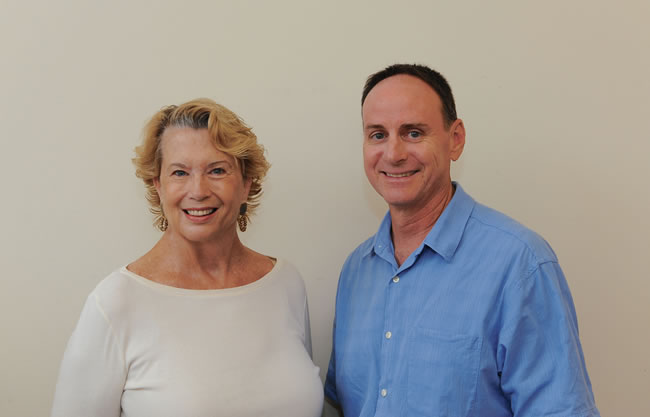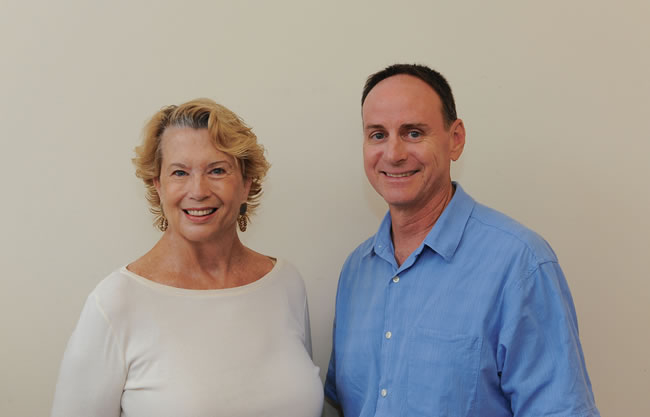Creating Suicide Awareness
Nancy Kern & Dr. Dan Galanis
State Department of Health Injury Prevention and Control Program
What is your role with the Department of Health?
Kern: I am the suicide prevention coordinator for the Injury Prevention and Control Program. I collaborate with our staff and people in the community in implementing initiatives to address suicide and suicide prevention. I’ve been with DOH for about 21 years and in this position for two years.
Galanis: I’m an epidemiologist – I’m the data person. In addition to suicide, things that fall under injuries are any sort of trauma. The major ones are traffic crashes, ocean safety and drownings; falls in the elderly is a big area, poisoning, pedestrian safety, assaults and homicides. I’m coming up on 15 years with DOH.
What are the demographics regarding suicide in Hawaii?
Galanis: Demographics are two different patterns
-those who died by suicide and those who survived an attempt. Among the fatal injuries, males predominate. They outnumber females three to one. Suicide is fairly rare until the late teen years and then we have increasing rates until a peak around the 45-60s age range. The rates are also really high in residents 85 and older. These are generally end-of-life, pain and terminal illness issues. It’s a pretty broadly distributed risk pattern and it’s similar to the national pattern.
Do attempts more often survive, or are they more often lethal?
Kern: Males complete suicides more often than females do, but females attempt suicide more often than males. That often has to do with the means they’re using. Females may ingest drugs, whereas males might suffocate by hanging or use a firearm.
Galanis: Poisoning attempts can be from commonly used and accessible substances such as Tylenol. The high-risk age is in the teen years for attempts – teenage girls.
Kern: A YRBS (youth risk behavior survey) is given to middle and high schoolers every other year by most states around the country. It’s supported by the Centers for Disease Control, and here it’s a collaboration between DOE and DOH. From 1995 to 2009, Hawaii high school students scored highest compared to students in any other state for thinking about planning and attempting suicide, which is very worrisome to us. The results from the 2011 YRBS were slightly more promising. We’re looking at focusing a significant number of our activities toward that high-risk population.
Is there data on the main reasons people in Hawaii attempt or commit suicide?
Galanis: It doesn’t look like the obvious thing is economic issues because financial problems were not a more prevalent cause among the more recent deaths than it was in 2000 to 2004, when we first did this research.
Kern: People who are at high risk for suicide appear to be people who have attempted before; people who have a mental illness such as depression, bipolar, schizophrenia; people who abuse drugs or alcohol; and people with challenging relationship issues.
Between 85 percent and 95 percent of people who attempt or complete suicide appear to have a mental health diagnosis. That’s a huge issue. We try to work closely with the agencies that are serving people with mental health challenges because of that correlation between mental illness and risk for suicide.
Do you work with the military?
Kern: The military has a huge proportion of suicides. We collaborate with them and we have a Prevent Suicide Hawaii task force. It’s a statewide group of people who represent various agencies, who come together to look at topics related to suicide and suicide prevention, and make decisions about how to address them.
What steps can a family or community member take to identify someone at risk and help them?
Kern: That is the main assistance that somebody at risk for suicide can have – that somebody in the community, a family member, friend, somebody they work with – recognizes the signs of suicide and takes time to talk with that person directly: How are you feeling, how are you doing? Are you thinking about killing yourself? If the answer is yes, then removing the means they were planning to use and getting them professional help is essential, be it a family physician, psychiatrist, psychologist, therapist or counselor. In order to do that, people have to be trained. Most of us don’t know how to recognize someone who’s at risk for suicide and then how to interact with them. We have training. One is a general three-hour training that provides people with skills on identifying those at risk, talking with them and referring them for help. Then there’s a two-day training called ASIST (applied suicide intervention skills training) that provides people with these same skills, but they actually role-play and practice what they would say to this person. (Call Nancy Kern at 733-9238 or go to hawaii.gov/health for upcoming training sessions, which are generally free.)
Anything you’d like to add?
Galanis: People on Neighbor Islands seem to be at a higher risk for both attempts and completion versus those living on Oahu. It’s consistent with rural areas having a higher suicide rate than more urbanized living situations.
Kern: It may be that there’s not as much access to services in rural areas. Another problem is stigma. We believe stigma is one of the major reasons people do not access the health care and assistance they need. Many people are afraid to talk about suicide, understandably so. Even if they’re going through a rough time, they don’t talk about it with friends, neighbors and colleagues because they’re fearful of what people will think about them, so they choose not to access the services. The bottom line is people need to start talking about suicide and learning more about it so that individuals do not feel fearful or ashamed to access the services they need.







